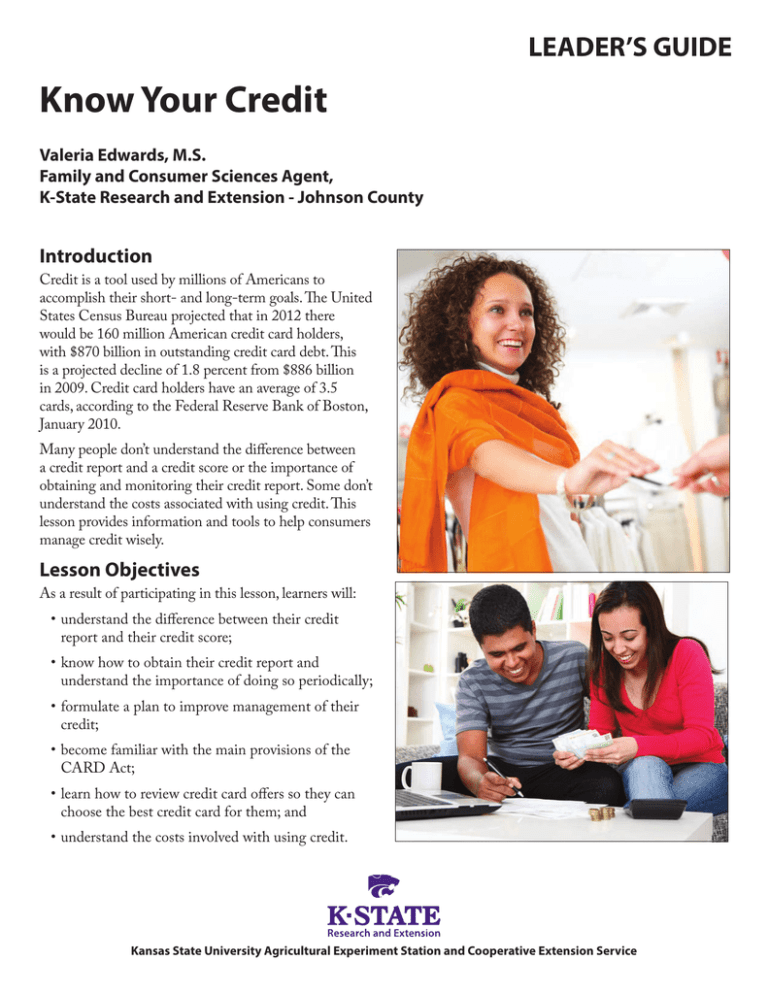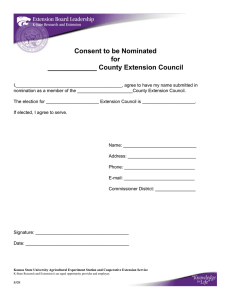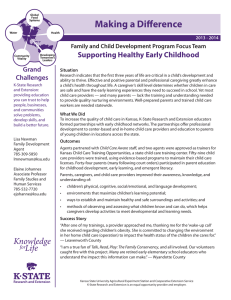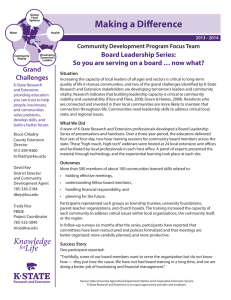
LEADER’S GUIDE
Know Your Credit
Valeria Edwards, M.S.
Family and Consumer Sciences Agent,
K-State Research and Extension - Johnson County
Introduction
Credit is a tool used by millions of Americans to
accomplish their short- and long-term goals. The United
States Census Bureau projected that in 2012 there
would be 160 million American credit card holders,
with $870 billion in outstanding credit card debt. This
is a projected decline of 1.8 percent from $886 billion
in 2009. Credit card holders have an average of 3.5
cards, according to the Federal Reserve Bank of Boston,
January 2010.
Many people don’t understand the difference between
a credit report and a credit score or the importance of
obtaining and monitoring their credit report. Some don’t
understand the costs associated with using credit. This
lesson provides information and tools to help consumers
manage credit wisely.
Lesson Objectives
As a result of participating in this lesson, learners will:
•understand the difference between their credit
report and their credit score;
•know how to obtain their credit report and
understand the importance of doing so periodically;
•formulate a plan to improve management of their
credit;
•become familiar with the main provisions of the
CARD Act;
•learn how to review credit card offers so they can
choose the best credit card for them; and
•understand the costs involved with using credit.
Kansas State University Agricultural Experiment Station and Cooperative Extension Service
Intended Audiences
holders, and other information may be found at www.
creditcards.com/credit-card-news/credit-card-industryfacts-personal-debt-statistics-1276.php.
Anyone who uses credit.
Before the Lesson
How Much Credit is too Much? from the University of
Illinois Extension available at web.extension.illinois.edu/
creditcardsmarts/decide_how_much_credit_is_too_much.
cfm?2
•Review the Know Your Credit fact sheet (MF3081)
and leader’s guide (MF3082).
•Obtain copies of the fact sheet for each participant.
Have learners complete and return evaluations to you.
Enter results into K-PICS.
•Review and download the PowerPoint presentation
from the K-State Research and Extension Family
and Consumer Sciences website, if you will use it.
Lesson Activities
•Become familiar with references and resources for
this lesson.
1. Have class participants obtain a copy of their
credit report.
•Discuss the lesson with a banker or financial or
credit professional in your community to gain
perspective on the educational needs of people
in your community regarding credit. Invite the
professional to partner with you to present the
lesson in an unbiased manner.
a. When appropriate, have learners bring a copy
of their credit report to class. Use class time
to have them individually and confidentially
review and analyze their own credit report.
Guide learners in developing an action plan to
correct incomplete or inaccurate information.
•Provide clipboards or other hard surfaces for note
taking.
b. With sufficient, secure Internet access, have
learners obtain and print their credit report
during class. Use class time to have them
individually and confidentially review and
analyze their own credit report. Guide learners
in developing an action plan to correct
incomplete or inaccurate information.
•Arrange chairs in a circle or semi-circle to
encourage discussion and information sharing.
Presenting the Lesson
Share “ground rules” of the session with learners,
adapted from Making Your Money Work, Purdue
University Extension, Trainer’s Guide (CFS-679G).
c. Encourage learners to request, review, and
analyze their credit report after class and to
develop an action plan to correct incomplete or
inaccurate information.
1. Respect views of others.
2. Listen to each other.
2. Bring samples of credit card offers or credit card
contracts for learners to analyze during class. Ensure
personal identity information is removed. Identify
favorable and unfavorable aspects of each offer or
contract, and rank in order from best to worst.
3. Share feelings/thoughts.
4. Be open to new ideas.
5. Suspend judgment.
Summarize objectives. Ask learners if there are other
issues they came to learn about, make a list of those
issues on a whiteboard or flipchart, and address as time
and knowledge allows. Offer to research issues as needed
and respond to the participant after class.
3. Bring samples of credit card bills, ensuring
personal identity information is removed.
a. Review information presented on the bill,
including annual percentage rates, fees,
transactions listed, due date, and other entries
on the bill. Lead a class discussion on how this
information is useful to a credit card holder.
Present information in the first paragraph of the
leader’s guide. Present the lesson, using the PowerPoint
slides and/or fact sheet for content. Incorporate one
or more lesson activities below, depending on time,
computer access, and your learners.
b. Discuss the matrix on each bill that shows how
long it would take to pay off the existing balance
and the total interest cost if only required
minimum payments are made, a requirement of
the CARD Act.
Share additional resources with the class. Credit card
statistics including number of cards, number of card
2
Author
c. Demonstrate the Credit Card Repayment
Calculator on the Federal Trade Reserve’s
website and lead a class discussion about
repaying credit card balances. If Internet access
and computers are available, divide the class into
teams — one team per computer — to use the
calculator.
www.federalreserve.gov/creditcardcalculator
Valeria Edwards, M.S.
Family and Consumer Sciences Agent
K-State Research and Extension - Johnson County
11811 S. Sunset Drive, Suite 1500
Olathe, KS 66061-7057
Valeria.edwards@jocogov.org, 913-715-7000
4. Demonstrate the Credit Karma website or divide
the class into teams to explore the website. Lead
a class discussion about how they would use the
website to monitor their credit, or have teams
make a list and report to the entire class.
www.creditkarma.com
Reviewers
Elizabeth Kiss, Ph.D.
K-State Research and Extension
dekiss4@ksu.edu, 785-532-1946
Debra Wood, MS, CFP®
Family Resource Management Agent
K-State Research and Extension Central Kansas District
785-309-5850
dwood@ksu.edu
5. Show humorous videos about credit on this
website learnaboutcreditreports.org/. Have learners
discuss or write their reactions and observations.
Community Awareness Activities
1. Encourage learners to volunteer with a group of
young families, such as through a local Head Start,
religious group, or neighborhood organization, to
teach what they’ve learned about managing credit.
Jana Castanon
Certified Financial Educator
Community Outreach Coordinator
Apprisen
www.apprisen.com
2. When meeting with constituents regarding their
health insurance choices or income tax returns,
give them information about obtaining their free
credit report, and encourage them to monitor
their credit report regularly. To obtain a free credit
report: www.annualcreditreport.com, 1-877-3228228.
Crystal Futrell
FACS Program Assistant
K-State Research and Extension - Johnson County
913-715-7000
3
Know Your Credit Evaluation
As a result of participating in this lesson:
1. I understand the difference between my credit report and my credit score.
T
F
2. I know how to obtain my credit report periodically.
T
F
3. I know how to review the information on my credit report.
T
F
4. I know how to work with credit reporting agencies to correct incomplete or inaccurate information. T
F
5. Actions I plan to take to improve my credit score: _________________________________________________
6. A provision of the CARD Act that is beneficial to me is___________________________.
7. I know what to consider when I want to open a new credit card account.
T
F
8. A cost of using credit I prefer to avoid is ______________________________________.
9. Because I used credit to purchase it, I may have spent more than I planned when I purchased _______________
________________________________________________________.
Why am I asking for your contact information? To help us improve this program, we want to know about the
behaviors changed or actions taken by participants after participating in this lesson. If you are willing to provide us
with follow-up information 30 to 60 days after your participation, please provide your contact information. Your
participation is entirely voluntary and your information will not be used in any other way.
Name:_________________________________________ Phone:_________________________
Email:____________________________________
Address: _______________________________________ City:______________________________
Zip:_____________
Publications from Kansas State University are available at: www.ksre.ksu.edu
Publications are reviewed or revised annually by appropriate faculty to reflect
current research and practice. Date shown is that of publication or last revision.
Contents of this publication may be freely reproduced for educational purposes.
All other rights reserved. In each case, credit Valeria Edwards, Know Your Credit,
Leader’s Guide, Kansas State University, August 2013.
Kansas State University Agricultural Experiment Station and Cooperative
Extension Service
K-State Research and Extension is an equal opportunity provider and employer.
Issued in furtherance of Cooperative Extension Work, Acts of May 8 and June
30, 1914, as amended. Kansas State University, County Extension Councils,
Extension Districts, and United States Department of Agriculture Cooperating,
John D. Floros, Director. MF3082
August 2013






